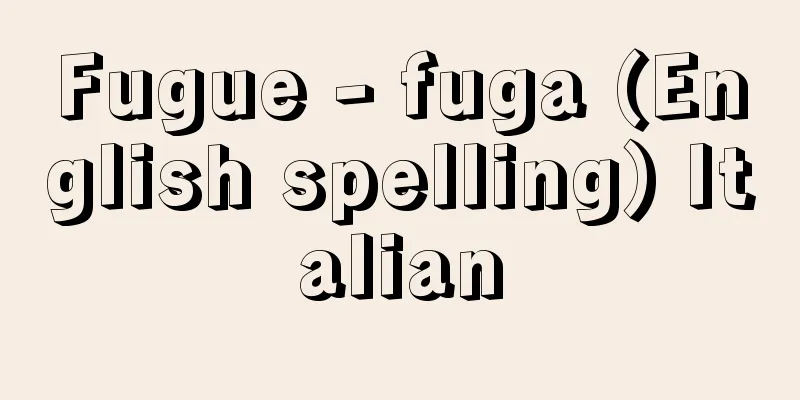Fugue - fuga (English spelling) Italian

|
It is sometimes translated as "fugue". Its original meaning is "escape", and as a musical term it originally meant a strict canon, but since the 17th century it has come to refer to the most perfect musical form or style of writing using imitative counterpoint. [Mariko Teramoto] The structure of a fugueFugues have changed throughout history and are extremely diverse, but all fugues share the following common features: they are written in contrapuntal style, based on a theme and its imitation by a certain number of voices (usually three or four), and the whole piece consists of an alternation of an exposition and an interlude. The number of expositions varies, but typically there are three parts. In this section, the theme is presented by one voice, and the other voices imitate it in turn. In this case, an imitation of the theme, usually a fifth above (a fourth below), i.e., a "response" to the theme, alternates with the original form of the theme. The voice that has finished presenting the theme continues to play a "counterpoint" ("counterpoint melody") when the next voice responds. After all the voices have presented the theme, the piece enters an interlude, in which a short motive derived from the theme or other parts is woven in a relatively free counterpoint. In addition to the above, techniques such as expanding or reducing the value of the theme, inversion of the theme, and stretta (where the response is inserted before the completion of the theme) are often used. In addition to the monothematic fugue, there are also polythematic fugues, which are called double fugues, triple fugues, etc., depending on the number of themes. [Mariko Teramoto] The History of FugueIt began with the establishment of instrumental forms of imitative counterpoint, such as ricercare and canzona, in Italy. These forms, developed by Andrea Gabrieli and Frescobaldi, were transmitted north by Sweelinck and Froberger, and developed into the fugue in 17th century Germany. Pachelbel, J.C.F. Fischer, Scheidt, and Buxtehude refined the form of the fugue and contributed to the refinement of contrapuntal techniques. J.S. Bach, who inherited their achievements, built the fugue at its pinnacle by combining it with new tonal and harmonic systems, and his fugues have incomparably artistic and unique themes and show extremely precise counterpoint. After Bach, the fugue was often used as a subdivision of other musical pieces, especially in Beethoven's later piano sonatas and string quartets, and in modern times, new styles of fugue can be found in Reger and Hindemith. [Mariko Teramoto] Source: Shogakukan Encyclopedia Nipponica About Encyclopedia Nipponica Information | Legend |
|
「遁走曲(とんそうきょく)」と訳されることもある。原義は「逃走」で、音楽用語としては、古くは厳格なカノンを意味したが、17世紀以来、模倣対位法によるもっとも完成された音楽形式または書法をさすようになった。 [寺本まり子] フーガの構造フーガは歴史的に変化し、きわめて多様であるが、すべてのフーガには次のような共通した特徴がみられる。すなわち、主題と一定数の声部(多くは三声または四声)によるその模倣を基礎にした対位法様式で書かれており、全体は主題提示部と間奏部との交代からなる。この主題提示部の数は一定ではないが、典型的にはおおむね三部分である。ここでは、主題がまず一声部に提示され、他の諸声部はそれを順に模倣していく。この場合、主題の通例五度上(四度下)の模倣、すなわち主題の「応答」と、主題の原形とが交互に現れる。そして主題の提示を終えた声部は、次の声部が応答を行うとき、引き続き「対位句」(「対位旋律」)を奏する。すべての声部が主題の提示を終えると間奏部に入るが、ここでは主題部分などに由来する短い動機が比較的自由な対位法で編まれている。なお、このほかにも、主題の音価の拡大や縮小、主題の転回、ストレッタ(応答が主題の完結以前に入ること)などの手法がしばしば用いられる。また、このような単主題のフーガに対して複主題のフーガもあり、主題の数に従って二重フーガ、三重フーガなどとよばれる。 [寺本まり子] フーガの歴史それはイタリアにおけるリチェルカーレやカンツォーナなどの、模倣的対位法による器楽形式の成立から始まる。アンドレア・ガブリエリやフレスコバルディの育てたこれらの形式は、スウェーリンクやフローベルガーらの手を経て北方に伝わり、17世紀のドイツでフーガへと発展した。パッヘルベルやJ・C・F・フィッシャー、シャイト、ブクステフーデらはフーガの形式を整え、対位法技法を洗練することに貢献した。これらの業績を受け継いだJ・S・バッハは、調的、和声的な新しい体系との結合によって、フーガの頂点を築いたが、彼のフーガは、比類なく芸術的で個性的な主題をもち、きわめて、精密な対位法を示している。 バッハ以降、フーガは他の楽曲の一部として用いられることが多く、とくにベートーベンの後期のピアノ・ソナタや弦楽四重奏曲において重要な役割を果たしている。また現代では、レーガーやヒンデミットに新しいスタイルのフーガがみられる。 [寺本まり子] 出典 小学館 日本大百科全書(ニッポニカ)日本大百科全書(ニッポニカ)について 情報 | 凡例 |
Recommend
Cape pondweed
...In temperate regions such as Japan, it is usua...
Cabinet meeting executive meeting - Cabinet meeting executive meeting
...Because the Council of Ministers included econ...
En'i - En'i
A monk said to be the author of "Eden of Ippe...
Synchronized Swimming
A type of water sport. Participants swim to musica...
Koga [city] - Koga
A city in northern Fukuoka Prefecture. It was inco...
Uranium manufacturing and processing process - Uranium manufacturing and processing
...The life cycle of uranium (U) used to utilize ...
Schiff base
A general term for compounds discovered by the Ge...
Palmetto
A plant pattern with leaves that spread out like a...
bibliophile
...People who have this hobby are called biblioph...
Leakey, Richard
Born December 19, 1944. Nairobi, Kenyan anthropolo...
Iakchos
Ancient Greek god. He was the deification of the c...
Onychodactylus fischeri (English spelling) Onychodactylusfischeri
…Salamander [Takahiro Matsui]. . . *Some of the t...
Lilius, A. (English spelling) LiliusA
...So in 1577, Pope Gregory XIII organized a comm...
Caldera Lake - Calderaco
A lake that fills all or most of a caldera (a vol...
Ward chief - kucho
The heads of the 23 special wards of Tokyo and war...









